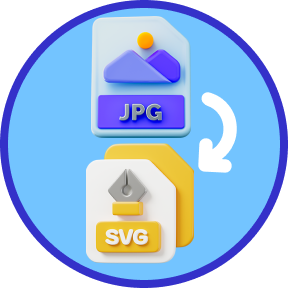Click the Choose Files button and select your JPG files.
Click on the Convert button to start the Conversion.
Status changes to Done; click the Download button to Download the Converted Files.
Once you download the Converted Files, click on Reuse Tool or Delete the File.
1 Easy to Use - Convert JPG to SVG tool is very easy to use.
2 Quality - Convert JPG to SVG tool gives the Highest Files quality.
3 Free and Secure - We upload your files over a secure HTTPS connection. The best part is that you do not have to log in or share any personal information to use the tools. Convert JPG to SVG tool is absolutely free and at the same time website is secure; you can use the tools unlimited. When you use the tools and process the files, after the completion of the process, your files are stored in our server for 15 minutes only, and the files get deleted automatically after 15 minutes. Or, once the file is downloaded, you can delete your file yourself by clicking the delete button.
4 Convert JPG to SVG tool works on any web browser with a secure HTTPS connection. So you can convert your files without worrying about file security and privacy.
5 Files Size - The maximum file size is 250 MB, you can process 250 MB files by uploading them in one process, but you can do it as many times as you want with all tools. The use of all tools is free and unlimited.
1 The history of the SVG file goes back to the late 1990s when the Web Consortium (W3C) welcomed propositions from developers for a brand-new kind of vector graphic format. Six competing proposals were sent and assisted notify what ultimately ended up being the W3C's SVG format.
2 Scalable Vector Graphics (SVG) is an XML-based vector image format for specifying two-dimensional graphics, assisting interactivity and animation. The SVG specification is an open basic established by the Web Consortium (W3C) in 1999. However, SVGs took a while to grow in popularity.
3 There was relatively little assistance for them till 2017, when people began to see the advantages of using SVGs in modern-day web browsers. SVG files are now extensively used for 2D site images since many internet browsers and drawing apps for vector files can quickly manage them.
1 Scalable Vector Graphics (SVG) is a web-friendly vector file format. Instead of pixel-based raster files like JPEGs, vector files save images via mathematical solutions based upon points and lines on a grid.
2 This indicates that vector files like SVG can be significantly resized without losing their quality, making them perfect for logo designs and complex online graphics. It's not simply their resizing abilities that make SVGs extremely popular with web designers.
3 SVGs are written in XML code, meaning they keep any text details as literal text instead of shapes. This enables online search engines like Google to read SVG graphics for their keywords, which can help a site increase search rankings.
4 You can quickly spot an SVG file by its .svg extension.
1 Unlike raster files, which are comprised of pixels, vector graphics like SVGs maintain their resolution-- no matter how big or small you make them. You don't need to fret about SVG images losing their quality in specific web browsers or when you resize them to appear in different places.
2 Basic SVG files are typically smaller than raster images, constructed from lots of colored pixels rather than mathematical algorithms.
3 Because SVG files treat text as text (and not as style), screen readers can scan any words included in SVG images. This is helpful for people who require help reading webpages. In addition, an online search engine can also read and index SVG image text.
1 As seen on web browsers and clever devices, the JPG file format is the bread and butter of everyday image file storage and display screen. Discover more about the history of JPG images, what to utilize them for, and how to maximize their compression capabilities.
2 JPG represents the Joint Photographic Specialists Group, an international organization that standardized the format during the late 1980s and early 1990s. It's the go-to format for digital images considering that expert photographers started snapping and saving images on digital webcams and other reprographic gadgets.
3 The term JPG is an acronym for the Joint Photographic Experts Group, which developed the requirement in 1992. JPG was primarily responsible for the proliferation of digital images and digital images throughout the Web and later on social networks.
1 JPG files are perhaps the most universally identified image file format- suitable with many web browsers, software, and apps.
2 Their small file sizes enable quick transfer and quick access for viewing online. By wisely disposing of all the colors that the human eye can't select-- called lossy compression- JPGs keep their file size as small as possible. Compared to lossless formats like GIFs, JPGs are dramatically smaller in size.
3 Post-processing is more accessible since the shutter's click sets white balance and saturation in JPGs.


